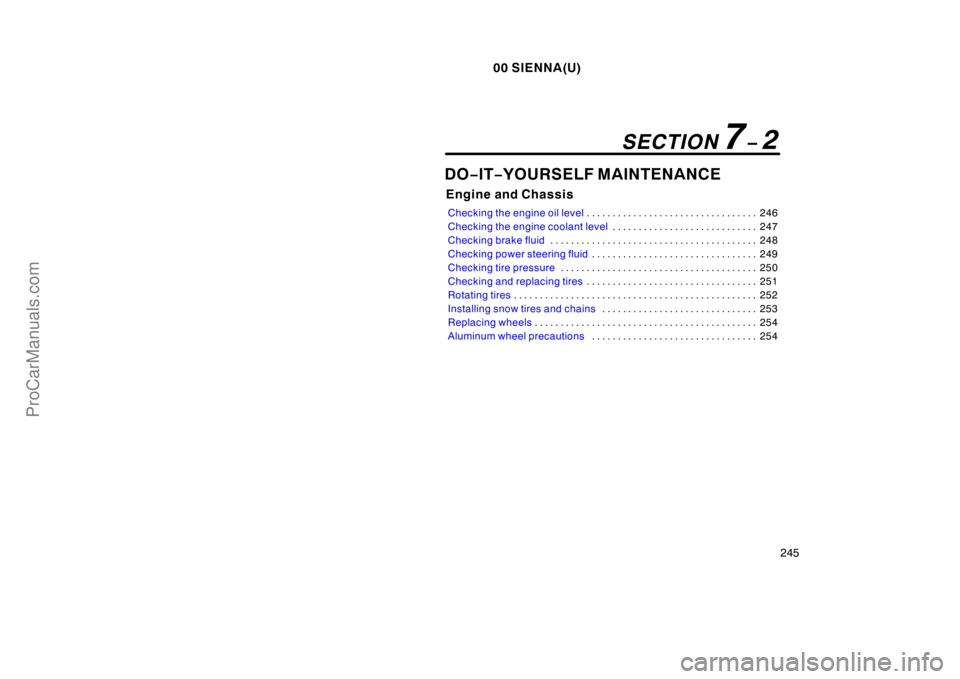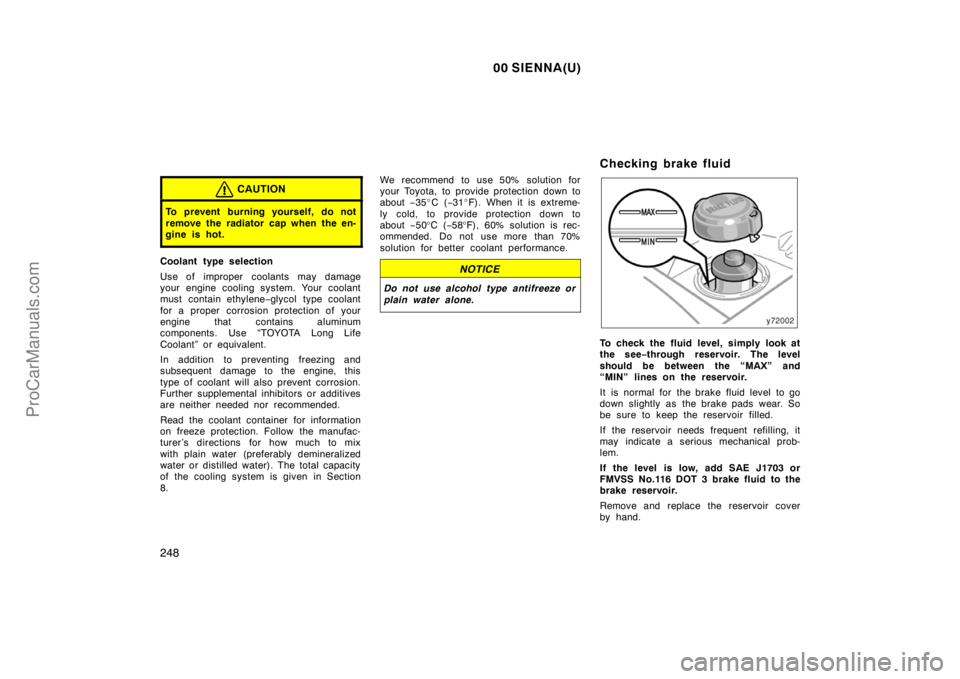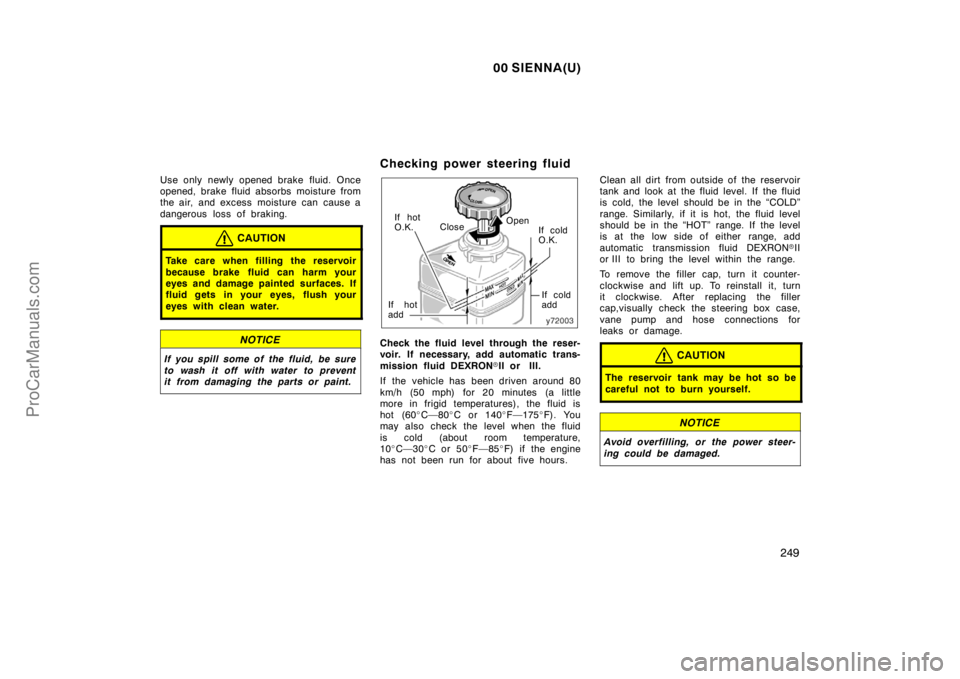Page 246 of 282
00 SIENNA(U)
240
Engine compartment overview
1. Engine coolant reservoir
2. Power steering fluid reservoir
3. Engine oil level dipstick
4. Engine oil filler cap
5. Brake fluid reservoir
6. Fuse blocks
7. Battery
8. Electric cooling fans
9. Windshield and rear window washer
fluid tank
ProCarManuals.com
Page 250 of 282

00 SIENNA(U)
244
Parts and tools
Here is a list of parts and tools you will
need on performing do−it−yourself mainte-
nance. Remember all Toyota parts are de-
signed in metric sizes, so your tools must
be metric.
Checking the engine oil level
Parts (if level is low):
�Engine oil API grade SJ,
“Energy−Conserving” or ILSAC multi-
grade having viscosity proper for your
climate
Tools:
�Rag or paper towel
�Funnel (only for adding oil)
Checking the engine coolant level
Parts (if level is low):
�“TOYOTA Long Life Coolant” or equiva-
lent
See Section 7−2 for details about cool-
ant type selection.
�Demineralized or distilled water
Tools:
�Funnel (only for adding coolant)Checking brake fluid
Parts (if level is low):
�SAE J1703 or FMVSS No.116 DOT 3
brake fluid
Tools:
�Rag or paper towel
�Funnel (only for adding fluid)
Checking power steering fluid
Parts (if level is low):
�Automatic transmission fluid
DEXRON®II or III
Tools:
�Rag or paper towel
�Funnel (only for adding fluid)
Checking battery condition
Tools:
�Warm water
�Baking soda
�Grease
�Conventional wrench (for terminal
clamp bolts)Checking and replacing fuses
Parts (if replacement is necessary):
�Genuine Toyota fuse or equivalent with
same amperage rating as original
Adding washer fluid
Parts:
�Water
�Washer fluid containing antifreeze (for
winter use)
Tools:
�Funnel
Replacing light bulbs
Parts:
�Bulb with same number and wattage
rating as original (See charts in
“Replacing light bulbs” in Section 7−3.)
Tools:
�Screwdriver
�Wrench
ProCarManuals.com
Page 251 of 282

00 SIENNA(U)
245
DO−IT−YOURSELF MAINTENANCE
Engine and Chassis
Checking the engine oil level246 . . . . . . . . . . . . . . . . . . . . . . . . . . . . . . . . .
Checking the engine coolant level247 . . . . . . . . . . . . . . . . . . . . . . . . . . . .
Checking brake fluid248 . . . . . . . . . . . . . . . . . . . . . . . . . . . . . . . . . . . . . . . .
Checking power steering fluid249 . . . . . . . . . . . . . . . . . . . . . . . . . . . . . . . .
Checking tire pressure250 . . . . . . . . . . . . . . . . . . . . . . . . . . . . . . . . . . . . . .
Checking and replacing tires251 . . . . . . . . . . . . . . . . . . . . . . . . . . . . . . . . .
Rotating tires252 . . . . . . . . . . . . . . . . . . . . . . . . . . . . . . . . . . . . . . . . . . . . . . .
Installing snow tires and chains253 . . . . . . . . . . . . . . . . . . . . . . . . . . . . . .
Replacing wheels254 . . . . . . . . . . . . . . . . . . . . . . . . . . . . . . . . . . . . . . . . . . .
Aluminum wheel precautions254 . . . . . . . . . . . . . . . . . . . . . . . . . . . . . . . .
SECTION 7− 2
ProCarManuals.com
Page 254 of 282

00 SIENNA(U)
248
CAUTION
To prevent burning yourself, do not
remove the radiator cap when the en-
gine is hot.
Coolant type selection
Use of improper coolants may damage
your engine cooling system. Your coolant
must contain ethylene−glycol type coolant
for a proper corrosion protection of your
engine that contains aluminum
components. Use “TOYOTA Long Life
Coolant” or equivalent.
In addition to preventing freezing and
subsequent damage to the engine, this
type of coolant will also prevent corrosion.
Further supplemental inhibitors or additives
are neither needed nor recommended.
Read the coolant container for information
on freeze protection. Follow the manufac-
turer’s directions for how much to mix
with plain water (preferably demineralized
water or distilled water). The total capacity
of the cooling system is given in Section
8.We recommend to use 50% solution for
your Toyota, to provide protection down to
about −35�C (−31�F). When it is extreme-
ly cold, to provide protection down to
about −50°C (−58°F), 60% solution is rec-
ommended. Do not use more than 70%
solution for better coolant performance.NOTICE
Do not use alcohol type antifreeze or
plain water alone.
Checking brake fluid
To check the fluid level, simply look at
the see−through reservoir. The level
should be between the “MAX” and
“MIN” lines on the reservoir.
It is normal for the brake fluid level to go
down slightly as the brake pads wear. So
be sure to keep the reservoir filled.
If the reservoir needs frequent refilling, it
may indicate a serious mechanical prob-
lem.
If the level is low, add SAE J1703 or
FMVSS No.116 DOT 3 brake fluid to the
brake reservoir.
Remove and replace the reservoir cover
by hand.
ProCarManuals.com
Page 255 of 282

00 SIENNA(U)
249
Use only newly opened brake fluid. Once
opened, brake fluid absorbs moisture from
the air, and excess moisture can cause a
dangerous loss of braking.
CAUTION
Take care when filling the reservoir
because brake fluid can harm your
eyes and damage painted surfaces. If
fluid gets in your eyes, flush your
eyes with clean water.
NOTICE
If you spill some of the fluid, be sure
to wash it off with water to prevent
it from damaging the parts or paint.
Checking power steering fluid
If hot
O.K.
If cold
O.K. Close
If hot
addIf cold
add Open
Check the fluid level through the reser-
voir. If necessary, add automatic trans-
mission fluid DEXRON�II or III.
If the vehicle has been driven around 80
km/h (50 mph) for 20 minutes (a little
more in frigid temperatures), the fluid is
hot (60�C—80�C or 140�F—175�F). You
may also check the level when the fluid
is cold (about room temperature,
10�C—30�C or 50�F—85�F) if the engine
has not been run for about five hours.Clean all dirt from outside of the reservoir
tank and look at the fluid level. If the fluid
is cold, the level should be in the “COLD”
range. Similarly, if it is hot, the fluid level
should be in the “HOT” range. If the level
is at the low side of either range, add
automatic transmission fluid DEXRON�II
or III to bring the level within the range.
To remove the filler cap, turn it counter-
clockwise and lift up. To reinstall it, turn
it clockwise. After replacing the filler
cap,visually check the steering box case,
vane pump and hose connections for
leaks or damage.
CAUTION
The reservoir tank may be hot so be
careful not to burn yourself.
NOTICE
Avoid overfilling, or the power steer-
ing could be damaged.
ProCarManuals.com
Page 274 of 282

00 SIENNA(U)
268
BATTERY
Open voltage
∗ at 20�C (68�F):
12.6—12.8 V Fully charged
12.2—12.4 V Half charged
11.8—12.0 V Discharged
∗: Voltage that is checked 20 minutes af-
ter the key is removed with all the
lights turned off
Charging rates:
5 A max.
AUTOMATIC TRANSAXLE
Automatic transmission
Fluid capacity (drain and refill),
L (qt., Imp. qt.):
Up to 3.5 (3.7, 3.1)
Fluid type:
Automatic transmission fluid D−ll or
DEXRON�III (DEXRON�II)
Differential
Fluid capacity L (qt., Imp. qt.):
0.8 (0.8, 0.7)
Fluid type:
Automatic transmission fluid D−II or
DEXRON�III (DEXRON�II)BRAKES
Minimum pedal clearance when depressed
with the pressure of 490 N (50 kgf, 110
lbf) with the engine running, mm (in.):
96 (3.8)
Pedal free play, mm (in.):
1—6 (0.04—0.24)
Pad wear limit, mm (in.):
1.0 (0.04)
Lining wear limit, mm (in.):
1.0 (0.04)
Parking brake adjustment when depressed
with the pressure of 294 N (30 kgf, 66
lbf):
3—5 clicks
Fluid type:
SAE J1703 or FMVSS No.116 DOT 3
STEERING
Wheel free play:
Less than 30 mm (1.2 in.)
Power steering fluid type:
Automatic transmission fluid DEXRON�II
or III
ProCarManuals.com